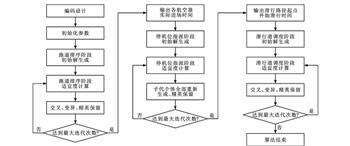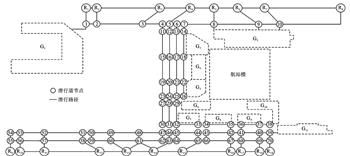| 大型机场进场航空器联合调度模型 |
| |
| 引用本文: | 姜雨, 刘振宇, 胡志韬, 吴薇薇, 王喆. 大型机场进场航空器联合调度模型[J]. 交通运输工程学报, 2022, 22(1): 205-215. doi: 10.19818/j.cnki.1671-1637.2022.01.017 |
| |
| 作者姓名: | 姜雨 刘振宇 胡志韬 吴薇薇 王喆 |
| |
| 作者单位: | 1.南京航空航天大学 民航学院, 江苏 南京 211106;;2.北京首都国际机场股份有限公司,北京 100621 |
| |
| 摘 要: | 
为减少进场航空器总延误与总滑行时间,研究了大型机场进场航空器联合调度问题;分别以跑道排序时间跨度和总延误加权和最小、被分配至远机位航班数量最少、进场航空器总滑行时间最短为目标函数,构建了跑道、停机位、滑行道三大系统的正向联合调度模型;在此基础上引入停机位再调整模型,通过调整额外滑行时间较大的航空器的停机位指派方案对滑行道调度进行反向优化;设计了一种改进型基因编码的遗传算法以避免非可行解的产生,提高求解效率。仿真结果表明:对比先到先服务策略,改进型遗传算法的进场航空器跑道排序时间减少了20 s,总延误从254 350 s降至199 760 s,减少了21%;对比蚁群算法,改进型遗传算法的总延误减少了20 060 s,降低了9%,且迭代曲线更平稳;改进遗传算法迭代12次时即能为进场航空器全部分配至近机位,18架进场航空器的总滑行时间从4 575 s降至4 145 s,降低了9%,且滑行过程中仅发生3次冲突;11架航空器均选择最短路滑行,仅3架航空器的额外滑行时间超过40 s;经停机位调整后,总额外滑行时间减少58 s,降低了27%。
可见,进场航空器联合调度模型能提高大型机场运行效率,为场面资源管理提供决策参考。

|
| 关 键 词: | 航空运输 航空器运行 联合调度 改进型遗传算法 反向优化 停机位调整 |
| 收稿时间: | 2021-09-10 |
| 本文献已被 万方数据 等数据库收录! |
| 点击此处可从《交通运输工程学报》浏览原始摘要信息 |
|
点击此处可从《交通运输工程学报》下载免费的PDF全文 |
|



